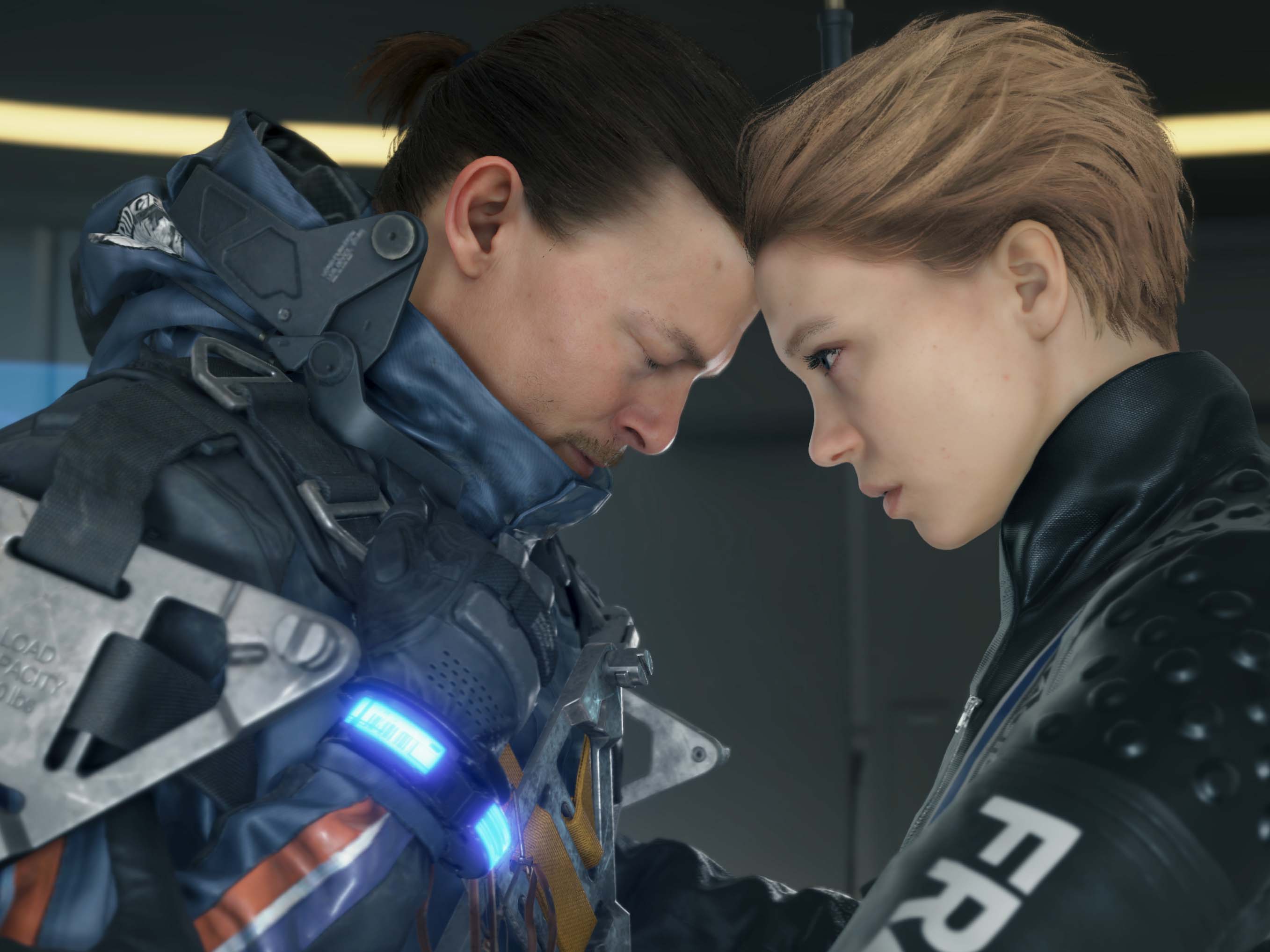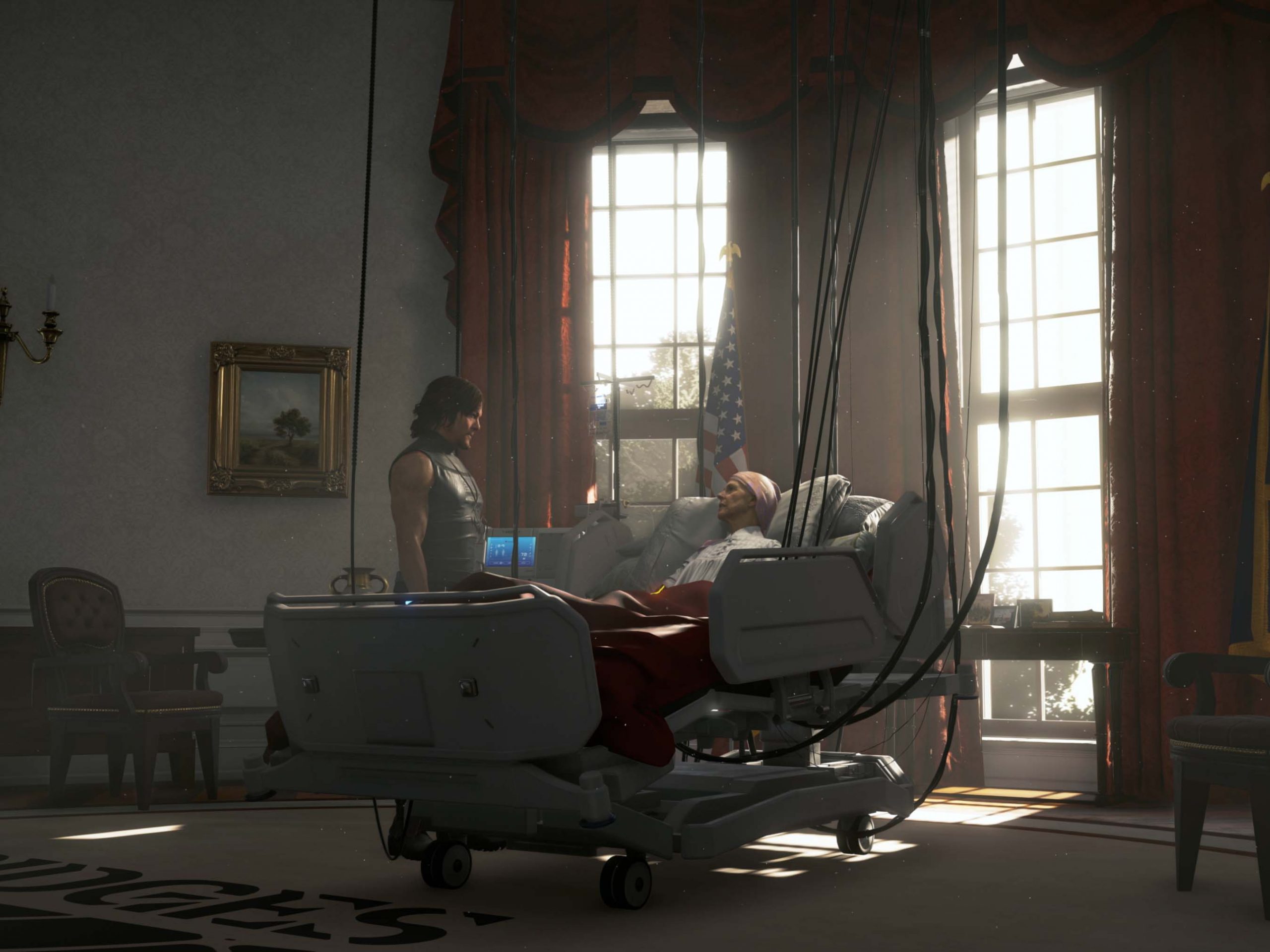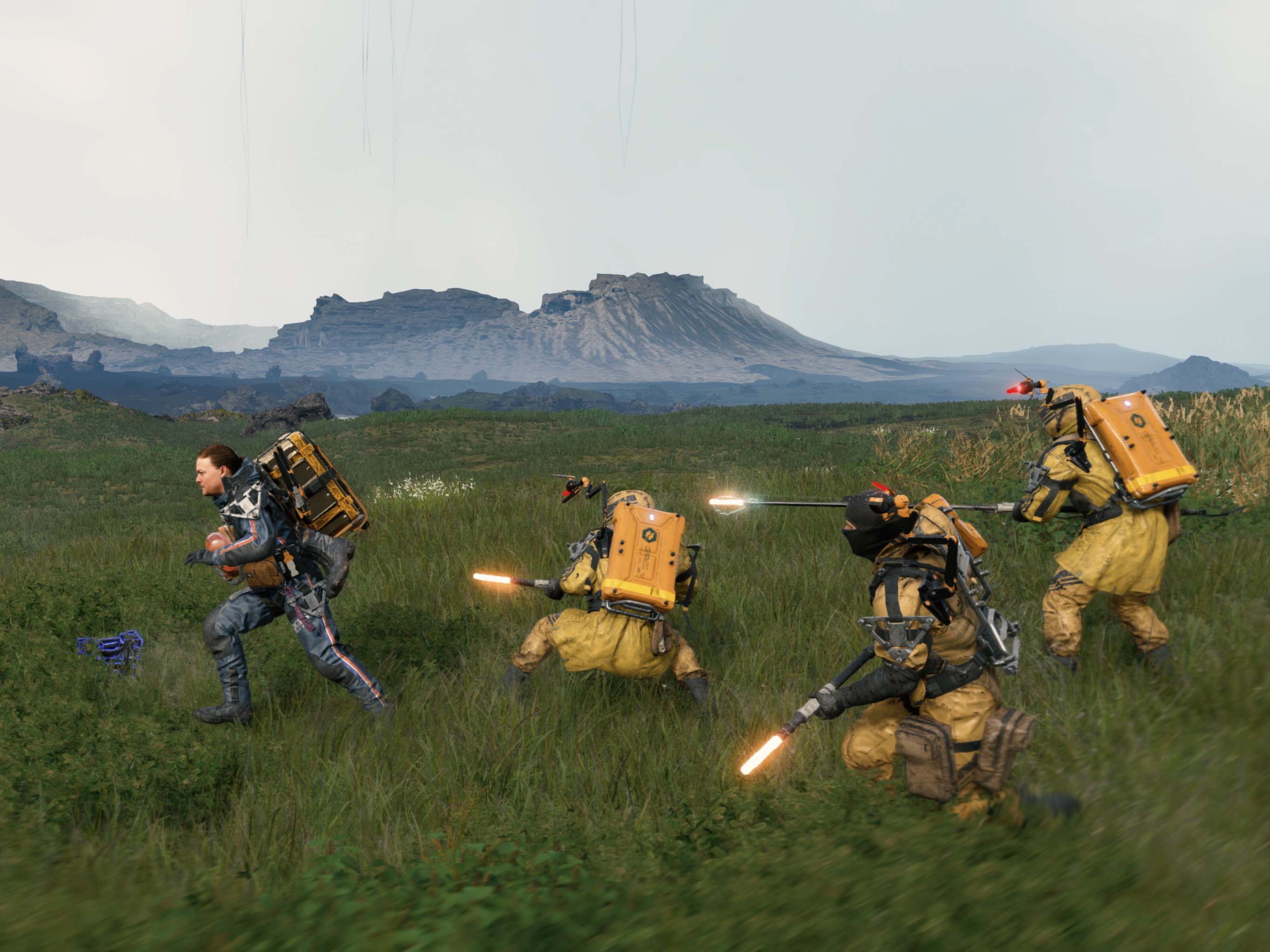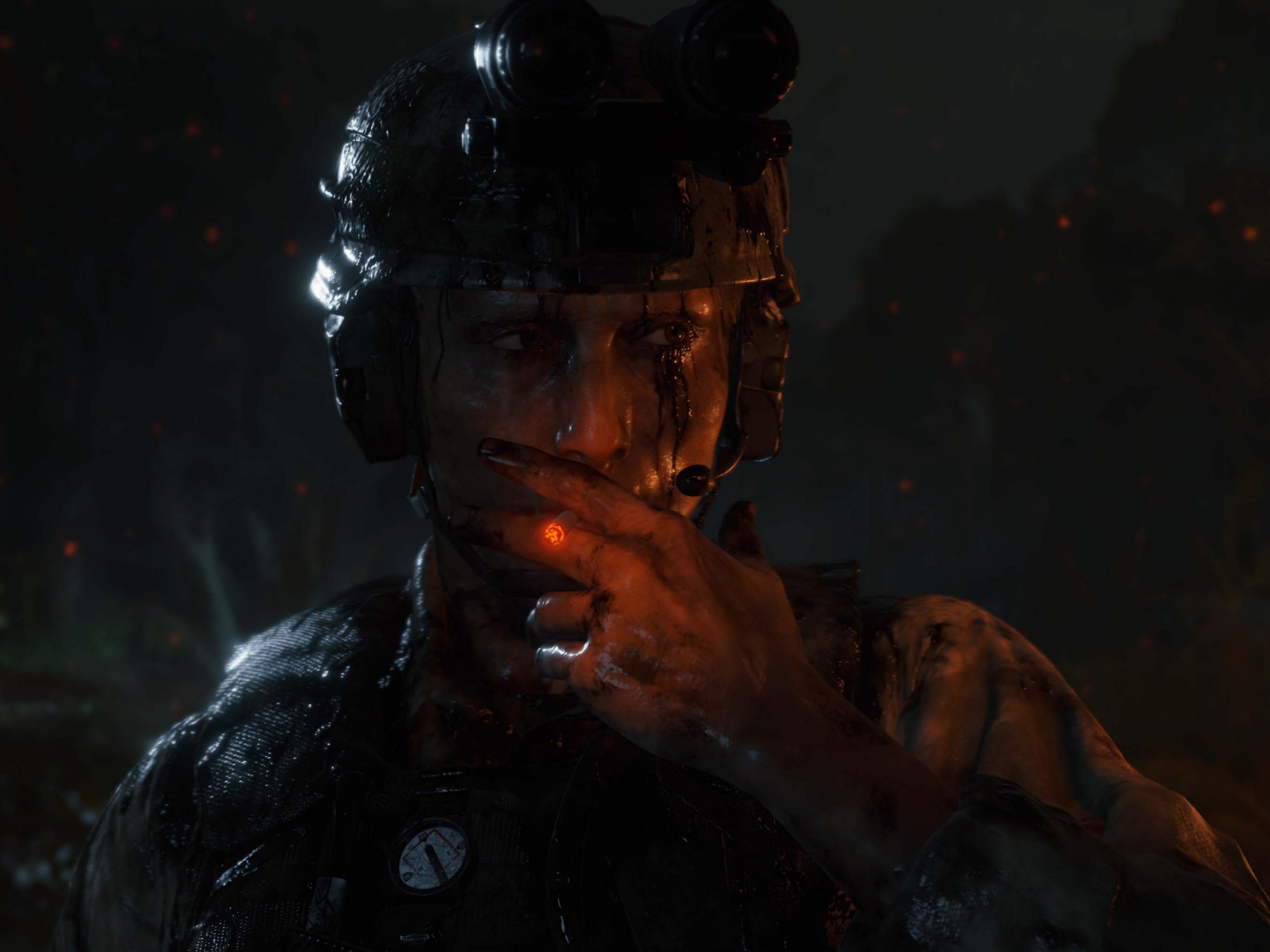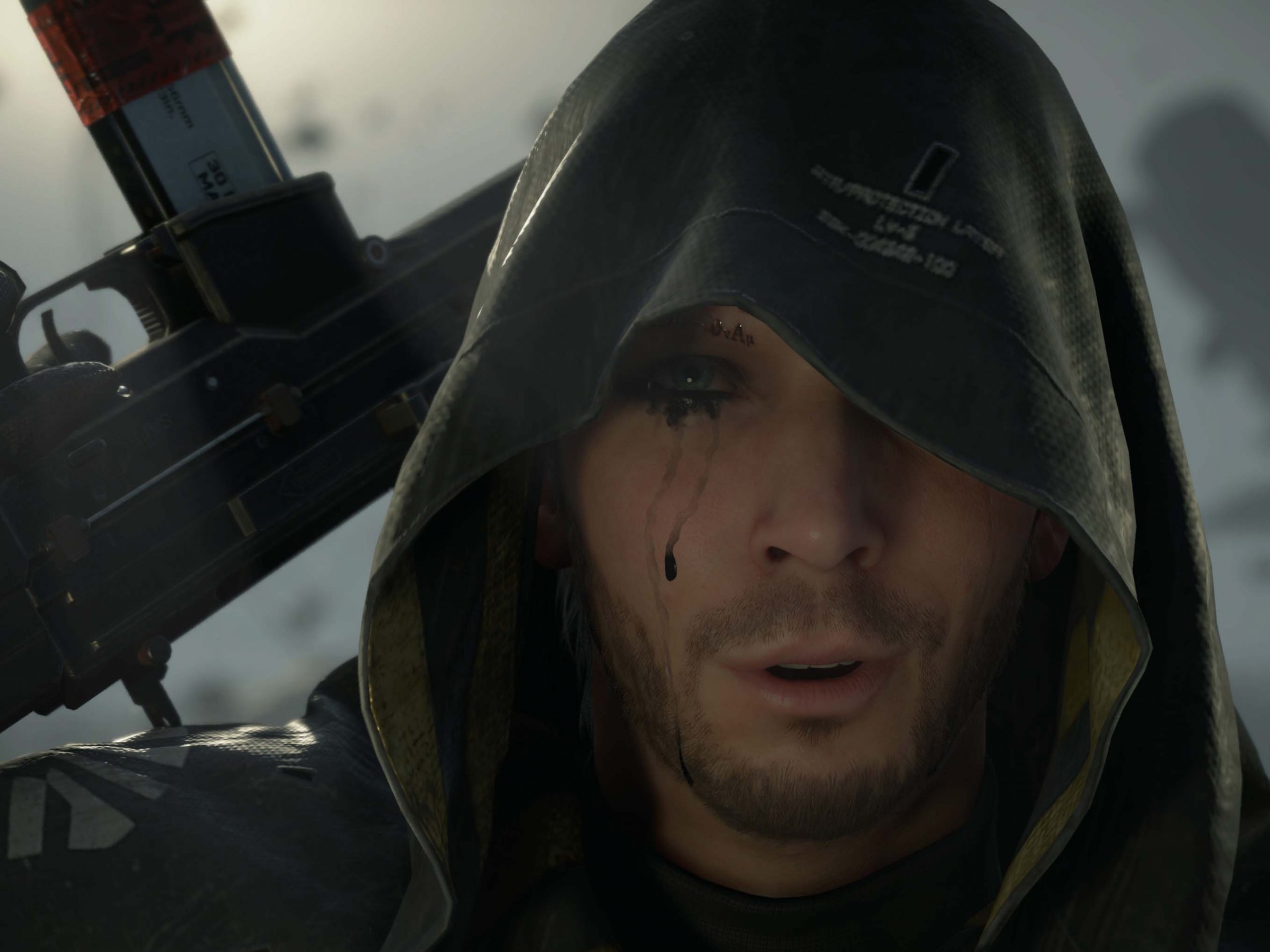Death Stranding review
You're all walk

In Marvel’s Spider-Man, the high-profile PlayStation 4 exclusive that launched in the second half of last year, upgrading Spidey allowed him to leap effortlessly across entire skyscrapers in Midtown Manhattan.
By contrast, 2019’s big PS4 title is Death Stranding, a game in which you’ll spend many, many hours trying to prevent the protagonist from falling flat on his arse while cautiously descending a hill. Nobody can accuse Sony’s console of lacking in variety.
Death Stranding is the first release from famed Metal Gear Solid creator Hideo Kojima and his development studio Kojima Productions since they parted ways with Konami after MGS 5. It is, then, quite a big deal, and the fact that nobody had a clue what the game actually was for years after it was first announced only added to the hype.
The self-styled auteur has slowly drip fed us information, but it was hard to make much sense of it. Babies in capsules, invisible monsters, urinating, ladders and Conan O’Brien cameos: even for Kojima this one looked weird.
Now it’s here, the obvious question is: is it good? But the answer is far less straightforward.
At its core, Death Stranding is a game about walking. Other stuff happens, particularly later on, but mostly, this is the first AAA walking simulator. You pick up a package, walk for miles and deliver it to someone. You have a chat with a not always friendly hologram, restock your supplies and then do it all over again. Essentially a 50+ hour fetch quest, Death Stranding is stupidly long, consistently baffling and so incredibly monotonous that it may well drive you to tears.
And yet, at times the game can be as strangely compelling as its maker, and its unapologetic refusal to conform is actually quite refreshing. Death Stranding has something to say – albeit with all the subtlety of a hand grenade – about America, the environmental crisis, fatherhood, technology, the gig economy, social media, the loss of community in the modern world, and perhaps even video games in general.
Confused? You probably still will be after the credits have rolled.
Reedus and weep
The review copy of Death Stranding kindly offered to us by Sony was conditional on us steering well clear of any story spoilers, so I will. But the basic setup is this: you play Sam Porter Bridges (Norman Reedus off of The Walking Dead), an almost entirely humourless deliveryman with a fear of being touched, who you quickly find out is something of a legend in his field.
Porters like Sam don’t struggle for work in this unrecognisable and very much Amazon-less near future America, all but obliterated by a series of cataclysmic explosions that have triggered a supernatural event known as the Death Stranding. The seam that once separated life and death has now been torn apart.
And so, as well as the complete collapse of civilisation, Sam and the rest of the human survivors have to contend with BTs (Beached Things), angry ghosts that roam the land of the living, and Timefall, rain that accelerates the passage of time for anything it touches. Luckily for Sam, he has a BB (a technically still unborn baby) strapped to his chest, which is able to sense nearby BTs. And as a repriate, he’s able to regenerate if killed. Kind of like a video game character!
Recruited by an organisation called Bridges, Sam is assigned the task of plodding back and forth across this largely uninhabited wasteland, delivering packages to people who now live in underground bunkers and hooking them up to the Chiral Network (the internet, basically), so his employers can rebuild their country and the world from the ashes.
Oh, and he’s asked by the President, who is also his mother, to rescue his sister Amelie from a terrorist called Higgs, but you sort of have to forget about her plight for most of the game.
In typical Kojima fashion, the first few hours of Death Stranding bombard you with lengthy cutscenes and exposition, but you’ll still feel like little has actually been explained, and even after 20 hours I was wishing for a glossary. It’s comically indulgent nonsense a lot of the time, and if you really want to dig into the convoluted lore you’re better off sifting through the explanatory emails NPCs will send you throughout the campaign. But it is at least full of gorgeous shots, and I was still invested in finding out what it was all leading to.
And Death Stranding‘s star-studded cast is pretty good on the whole. Reedus’ Sam is perhaps the most boring protagonist of this console generation, but an oily Mads Mikkelsen is having a lot of fun in his role (which I won’t talk about here), and Margaret Qualley’s turn as Mama is tinged with believable sadness. Guillermo del Toro plays (though doesn’t voice) the bumbling Deadman, adding what might be the game’s only comic relief.
Strand and deliver
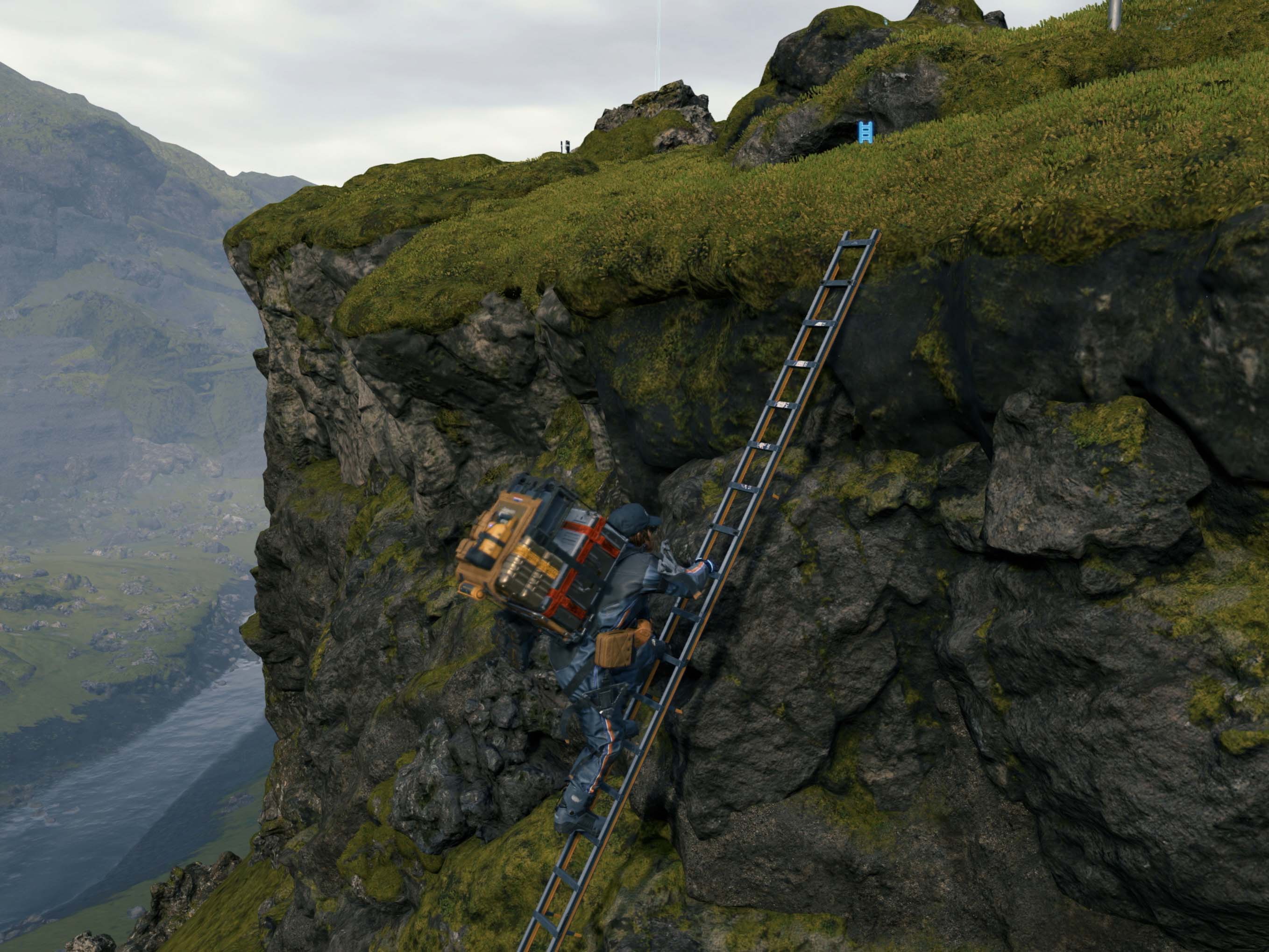
If that brief synopsis of Death Stranding‘s narrative has left you feeling understandably bewildered, rest assured that the vast majority of the gameplay is much easier to get your head around.
As mentioned, Sam is a porter, which means his job is to make deliveries and hook willing citizens up to the Chiral Network with a little dongle called a Q-Pid. At the end of an assignment you get a breakdown of how successful it was and an overall rating. Low damage earns you more ‘likes’, these digital endorsements being the game’s only real currency. Kojima has clearly been watching Black Mirror.
The beginning of each of the game’s 70 main story missions generally has you taking an order from an identikit delivery terminal, where you’ll have to micromanage how much cargo you can carry.
As well as your designated delivery items, you’ll need to consider practical things like ladders, climbing ropes and a spare pair of boots. Everything in the game gradually accumulates damage and in time will become unusable, especially if you’re hitting the deck on a regular basis. BB isn’t a fan of slippages either, and if it starts to cry you have to physically rock the controller until it stops.
Eventually 3D printed weapons are thrown into the mix, which means piling several more boxes onto the already wobbling tower on your back. Even at the beginning of the game Sam can lug a load that would have a World’s Strongest Man candidate nodding in approval, but you’ll soon unlock exoskeletons that enable you to strap even more gear to every spare inch of your body, as well as a floating drone that can take some of the weight off and even be ridden down hills.
You’ll spend an inordinate amount of time messing about with the infuriatingly fiddly inventory system, which does at least allow you to auto-arrange your cargo so you take less strain. But simple movement is by far Sam’s most challenging adversary in the game. When you squeeze the triggers on the DualShock he’ll grab the left and right straps on his backpack to steady himself. Forget to do so for even a few seconds and our pony-tailed postman heads face-first towards the mud, often dropping his meticulously assembled cargo in the process.
You’ll have to monitor your forward momentum on downhill stretches and keep an eye on your stamina bar on an incline. The latter can be resupplied by necking cans of Monster Energy drink, a corporation apparently unaffected by the apocalypse, while you can regain health by eating slugs. It’s not for everyone this porter lark.
Lonesome hero
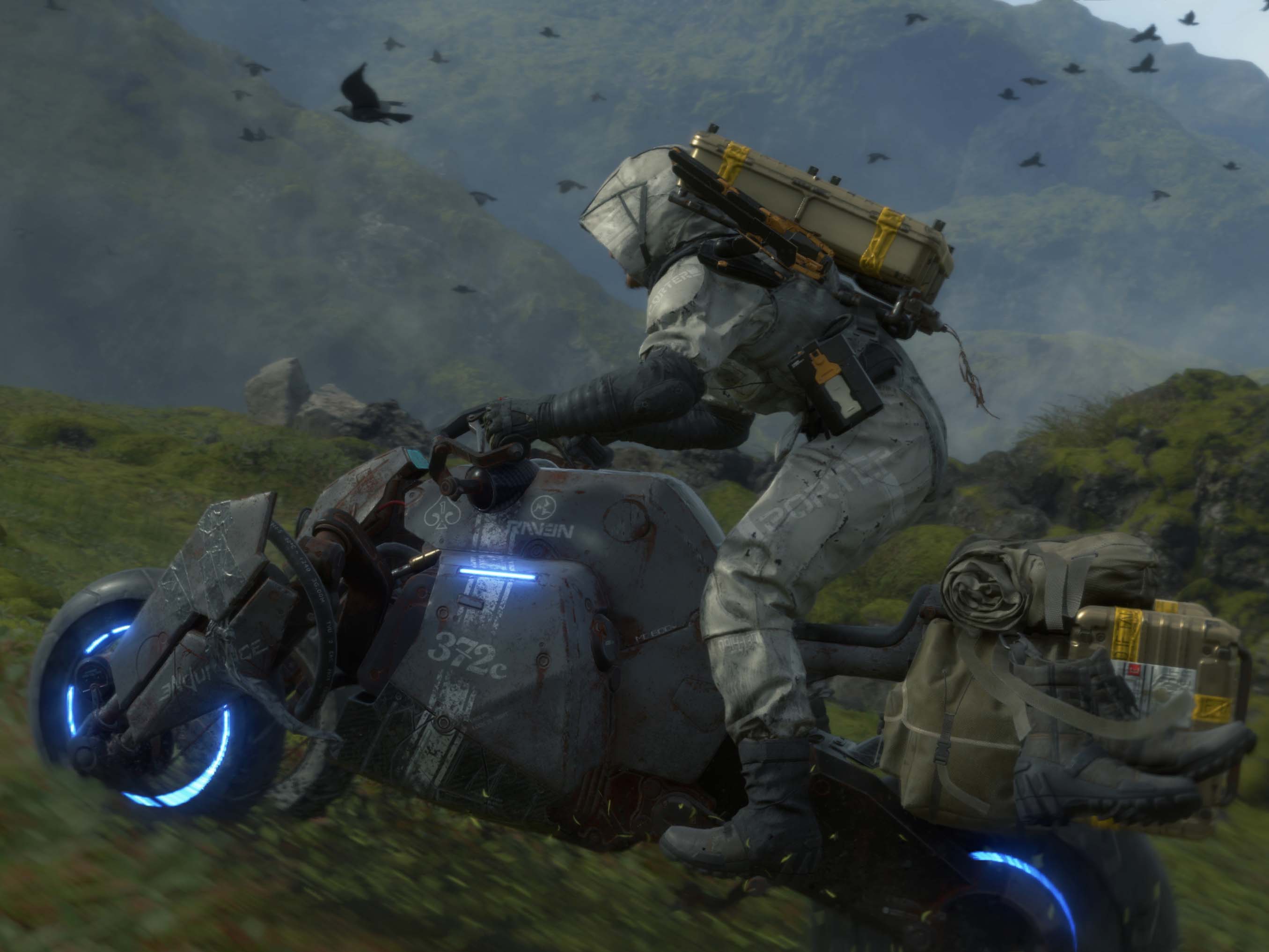
Seeing the end of Death Stranding probably depends on whether you can get through its absurdly lengthy third chapter, which is surprisingly light on in-game cinematics and very heavy on the deliveries. Gaining access to a garage of motorbikes and trucks speeds things up a bit, but not much.
In addition to the story-critical orders you’ll often be asked by characters you meet along the way to bring them things, particularly as word of your efficient delivering spreads. There probably wasn’t a task I took more seriously in the game than getting a pizza to my new pal while it was still hot.
Crossing the enormous stretches of terrain can be made easier by pulling up your map and using draggable lines to plot the best route. Not studying the topography properly means you’re more likely to have your delivery ruined by an impassable canyon, wide river (advice: do not fall over while crossing a river) or rock face that’s too high for your ladder.
If that all sounds more like hard work than fun, that’s because it is, but for me, hiking across Death Stranding‘s empty America is actually the best part of the game. While the landscape is bleak and lonely, it’s incredibly well-designed, graphically astonishing and oddly beautiful, and the game periodically punctuates your long treks across the rocky nothingness with songs from the ambient rock band, Low Roar. It works.
And as much as dragging Sam from the East to West Coast of this desolate country nearly broke me at times, there was a moment when I was lumbering up a mountain, knee deep in snow, stopping every few steps to recharge what was left of my nearly depleted stamina bar, and all too aware that one more unfortunate tumble would cause the bomb on my back to blow me into the blizzard – and I started to get what Kojima was going for. At its best, Death Stranding can be breathtaking.
Can’t strand me now
Kojima insists that Death Stranding has given birth to a new ‘strand’ genre of games, but there are times when when it turns into an action game, and not a great one at that.
The enemy you’ll come up against most often are called Mules, violent raiders who – and this is in no way a joke – became obsessed with making deliveries and will stop at nothing to hunt down any cargo they become aware of.
You’ll know when you’ve entered one of their expansive campsites because doing so will usually send out an alarm triggered by hidden motion detectors. If this happens you can either run for your life or fight the oncoming waves, which generally amounts to little more than mashing the punch button and countering attacks so you can tie them up. Much later you’ll gain access to a variety of lethal and non-lethal guns and grenades, although the game strongly advises that you opt for the latter. Kill someone and you’ll soon see why.
This being a Kojima game, there is technically a stealthy approach, facilitated by patches of long grass to hide in while you wait for the best moment to pounce on a patrolling Mule, but Solid Snake never had a swaying steel Jenga tower attached to his back. Getting hit by one usually results in your cargo falling to the ground, which is so frustrating that I tried to avoid combat for most of the game, only occasionally experimenting with my growing collection of gadgets.
Also getting in the way of Sam Porter Bridges’ important portering duties are BTs. The Death Stranding forged a connection between the living and the dead, meaning these howling apparitions wander the earth.
The first few encounters are incredibly tense. For reasons explained early in the game, your BB can sense nearby BTs, and you have a gizmo that’ll point in their general direction.
Paying attention to its activity while crouching, moving very slowly and holding your breath can get you past a BT herd(?) if you’re lucky, but you won’t evade them for the entire game.
The first time these predatory spectres drag you into the tar-like substance they travel in and you hear your panicking BB bawl through the controller’s speaker, it’s truly terrifying. But eventually they just become a progress-stalling irritance, and an ability you gain later on that gives you the upper hand is very welcome. Another useful tactic is to lob a grenade that can be engineered using your own blood, sweat and turd. Seriously.
Besides your numerous run-ins with Mules and BTs, the game – particularly in its later chapters, called episodes for no justifiable reason – is peppered with some MGS-reminiscent and somewhat out-of-place boss fights. They’re entertaining enough, but won’t go down in history like Kojima’s best Metal Gear clashes. And know this: all of the above is secondary to the walking.
I got you, brother
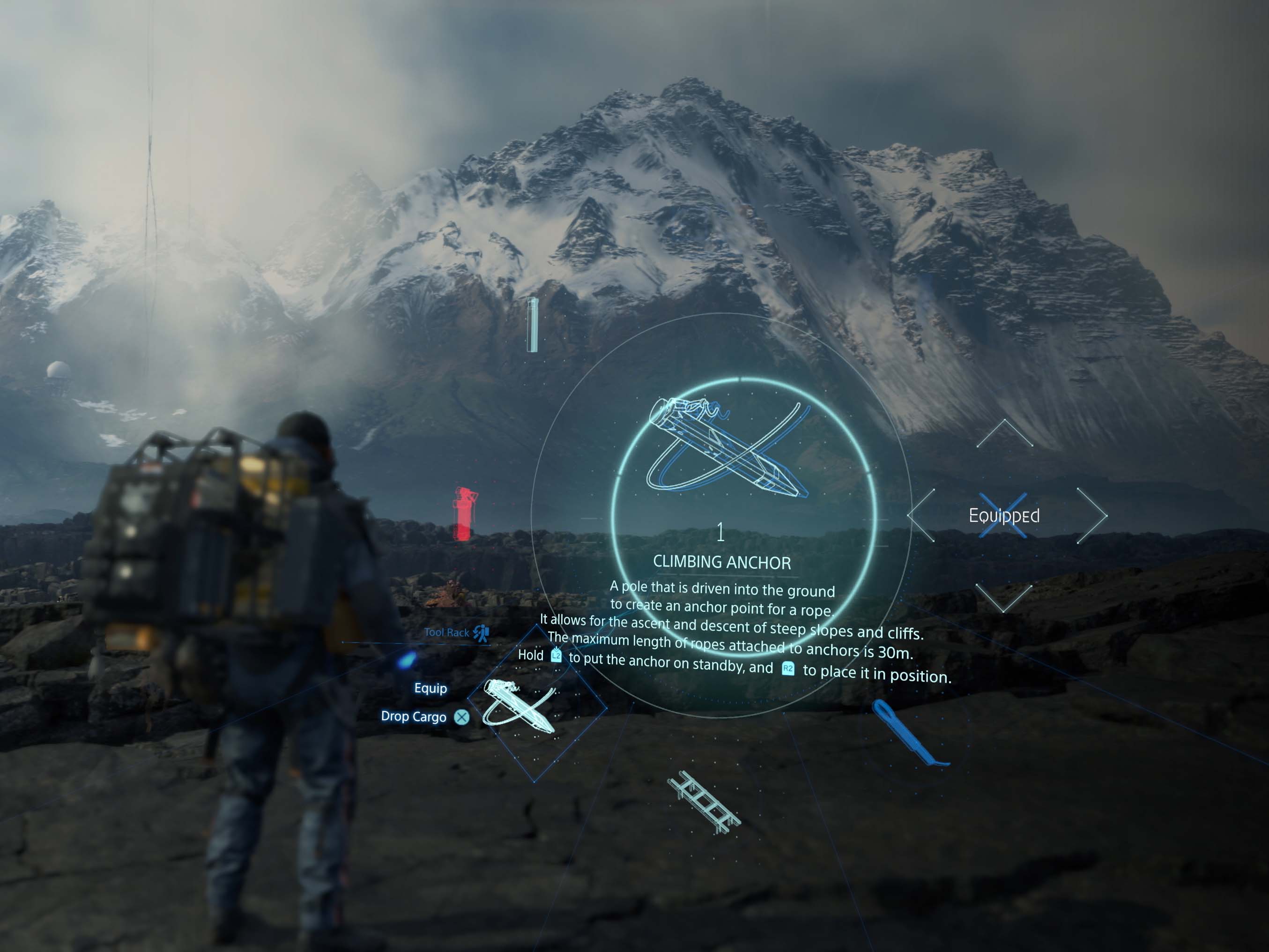
If any part of Death Stranding is resoundingly successful, it’s the online multiplayer component. While you never seen another player on your travels, you can leave ladders and ropes to aid them, while theirs will appear permanently in your game.
You can build communal postboxes and charging stations, and later the foundations for safe houses, roads and bridges, which other players can maintain and upgrade by donating materials. If someone uses something you’ve built they can give it likes, and amassing popularity among your fellow Norman Reedus’ quickly becomes quite addictive. You can even drop hazard badges to warn players about a threat ahead.
In open-world games you’re so often bombarded with icons from the off. Conversely, Death Stranding‘s gameworld is virtually barren until players populate it. You’re both reconnecting America and rebuilding it, and it’s nice to be able to work with your fellow gamers for once, rather than headshotting them with a sniper rifle.
Not only does knowing another player has walked the same path as you make feel less isolated, but it’s often the difference between reaching your destination in good time and being forced to take a different route. MrKaboomStick321, I wish you knew what that glowing green ladder icon meant to me.
Death Stranding verdict
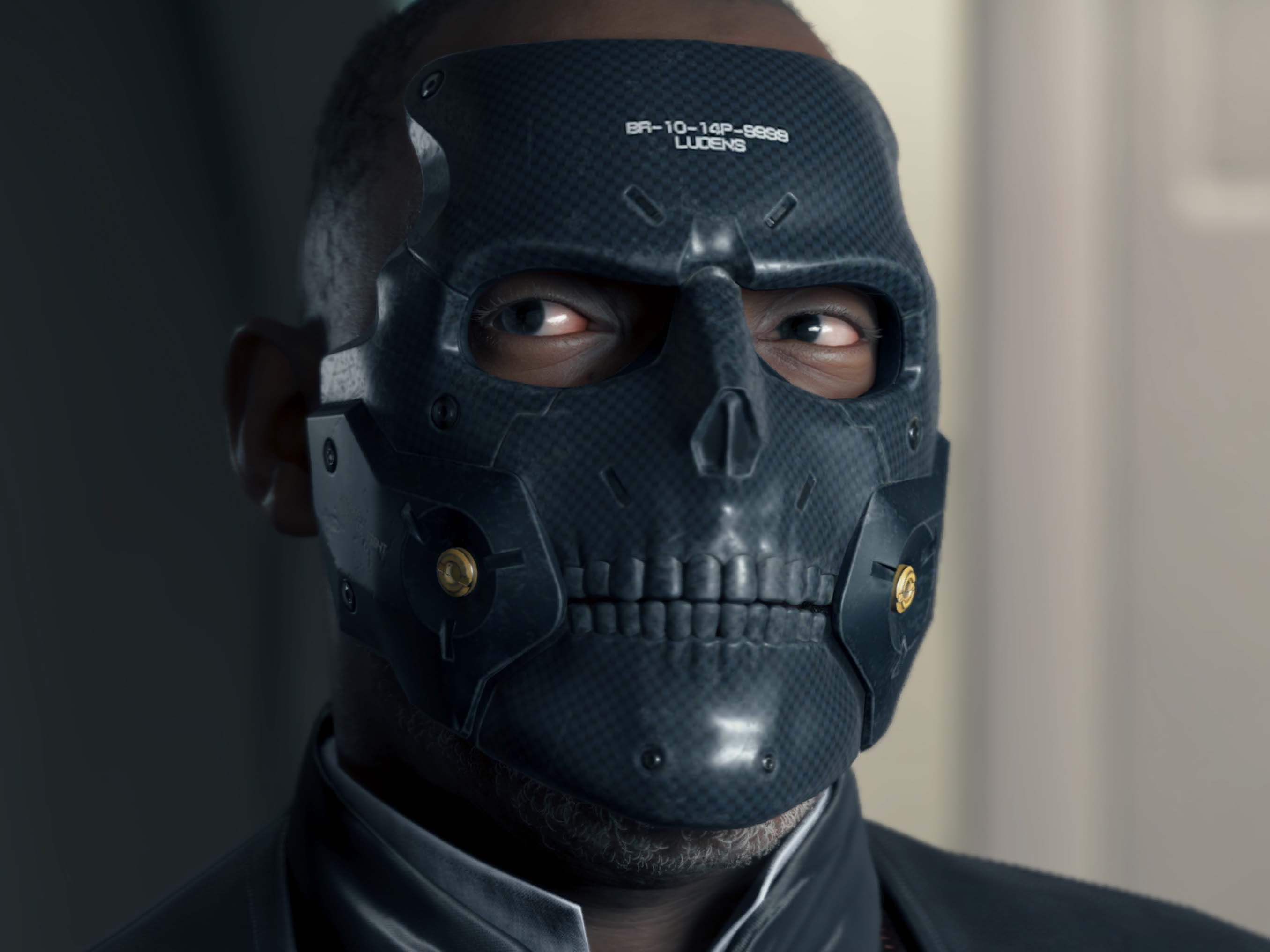
How do you summarise a game like Death Stranding? It’s at once the most boring and bizarrely absorbing adventure you can have on the PS4, an unrelenting slog of a game that has very little respect for your time, but in its quieter, meditative moments, it’s like nothing else.
It’s easy to foresee a lot of people giving up before the narrative really starts to unfold, and honestly, there’s little in the story itself that makes persevering worthwhile.
Instead, it’ll be a combination of wanting to see every inch of this strange dystopian wilderness, a growing bond with the needy tank baby, and sheer determination to finish the job that’ll see willing players through.
Death Stranding isn’t a memorable action game. It’s definitely not a stealth game either. It’s laughably self-serious, hard to call fun, and it will deservedly be the most divisive big-budget title of this console generation. But somehow, this endlessly weird game about walking mercilessly long distances with too much weight on your back is kind of brilliant too, and it’s something we should all be glad exists.
Stuff Says…
Love it or hate it (and you’ll probably flip between both), Death Stranding is an experience like no other
Good Stuff
Amazing world
Looks stunning
Planning a route and getting there in one piece feels rewarding
Online features are superbly implemented
Bad Stuff
Messy storytelling
Very uneven pacing
Inventory management should have been much better
Clunky combat
